Enterprise-Led, Government-Supported, Market-Driven Development Model: Guangzhou Knowledge City

26 February 2018

3.00pm - 5.30pm. Registration from 2.30pm, seated by 3.00pm

MND Auditorium, MND Annex A, 5 Maxwell Road Singapore 069110

2 SIP CPD pts, 2 SILA CPD pts
Resources
Lecture Video & Photos
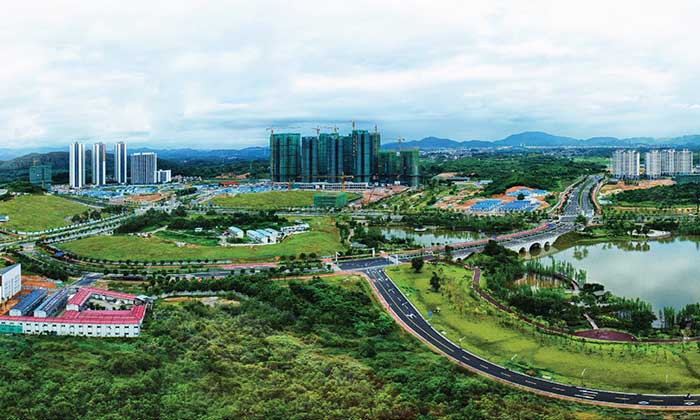 Aerial View of Sino-Singapore Guangzhou Knowledge City, Southern Start-Up Area. Source: Ascendas-Singbridge
Aerial View of Sino-Singapore Guangzhou Knowledge City, Southern Start-Up Area. Source: Ascendas-Singbridge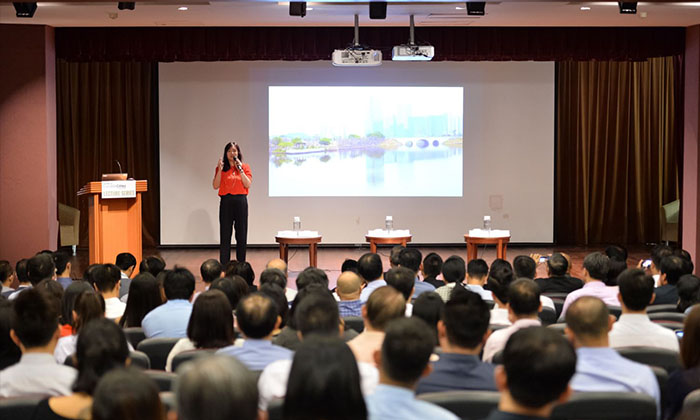 CEO of Ascendas-Singbridge’s Sustainable Urban Development Nina Yang shares about the developing the ecosystem for Guangzhou Knowledge City. Source: Centre for Liveable Cities
CEO of Ascendas-Singbridge’s Sustainable Urban Development Nina Yang shares about the developing the ecosystem for Guangzhou Knowledge City. Source: Centre for Liveable Cities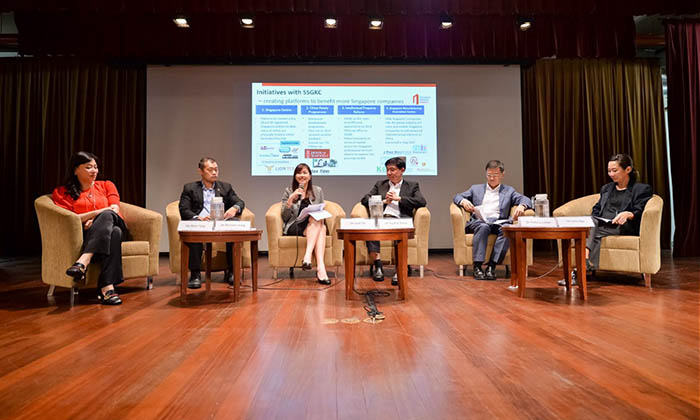 The panel, consisting of public and private sector players discussed enterprise-led, government-supported and market-driven collaborations in Guangzhou Knowledge City. Source: Centre for Liveable Cities
The panel, consisting of public and private sector players discussed enterprise-led, government-supported and market-driven collaborations in Guangzhou Knowledge City. Source: Centre for Liveable Cities 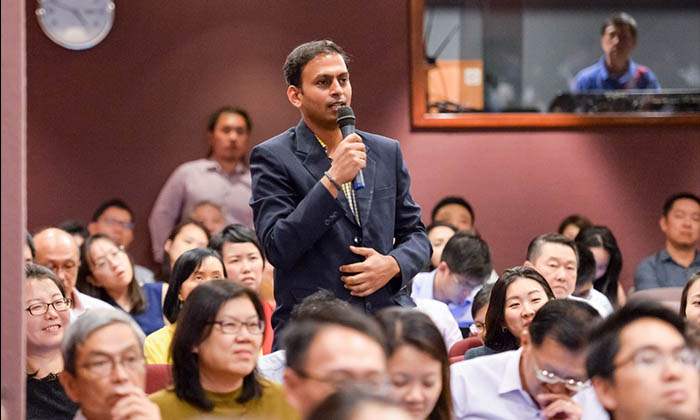 Participants are given a chance to interact with the panellists during the Question & Answer session. Source: Centre for Liveable Cities
Participants are given a chance to interact with the panellists during the Question & Answer session. Source: Centre for Liveable Cities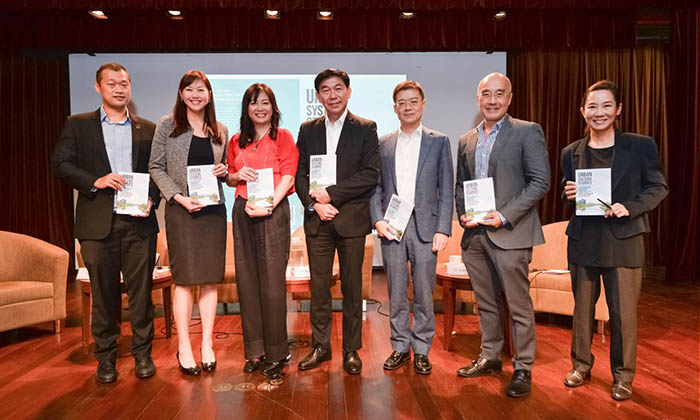 Panellists are presented with the Urban Systems Studies book as a token of appreciation for their time and contribution to this knowledge sharing session. Source: Centre for Liveable Cities
Panellists are presented with the Urban Systems Studies book as a token of appreciation for their time and contribution to this knowledge sharing session. Source: Centre for Liveable Cities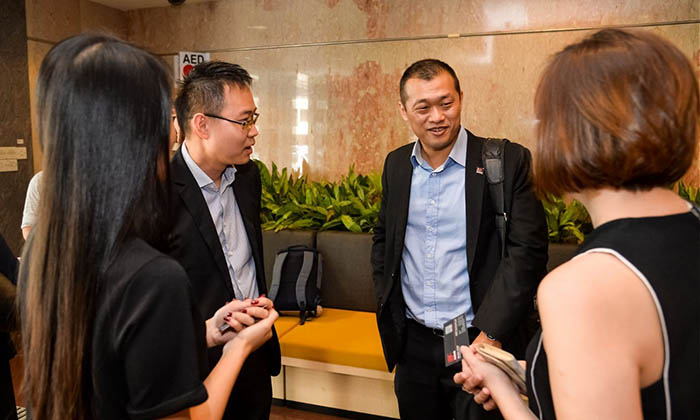 Lecture attendees take the opportunity to network with Michael Leong, Chief Executive Officer of Sesto Robotics, as he shares more about his experiences in Guangzhou after the lecture. Source: Centre for Liveable Cities
Lecture attendees take the opportunity to network with Michael Leong, Chief Executive Officer of Sesto Robotics, as he shares more about his experiences in Guangzhou after the lecture. Source: Centre for Liveable Cities
Synopsis
From the Suzhou Industrial Park in the 1990s, to the Eco-City establishment in the 2000s, Singapore’s collaboration with the Chinese in Suzhou and Tianjin has shed much light on the evolving needs of China over the years. Looking ahead, China’s market, which comprises maturing industrial developments and a strong economy, is looking to upgrade to knowledge-based and higher value-added industries.
Lecture Report
Singapore is not a technology powerhouse, but we are a very good aggregator,
able to put together all the hardware, the software and the intangibles that
make a city liveable. That’s why we have been focusing not only on the physical
development and infrastructure, which the Chinese are very good at, but also
on things like [intellectual property] and good schools.
- Ng Kok Siong, Chief Executive Officer,
Sino-Singapore Guangzhou Knowledge City
Governments around the world are under pressure to develop new urban centres, and many are
turning to the private sector for help because of their limited resources.
One example is the Sino-Singapore Guangzhou Knowledge City (GKC) by Ascendas-Singbridge. The
Singapore urban and business space solutions provider is the master developer of this upcoming city
that aims to attract skilled manpower and knowledge-based industries.
“It goes beyond physical development — we did not just do infrastructure provision such as the
roads, the water, we were also involved heavily in industrial development and strategic collaboration,”
said Ng Kok Siong, Chief Executive Officer of this joint venture development, at the launch of the
publication, Guangzhou Knowledge City: A New Paradigm in Collaboration. He was joined by speakers
across the public and private sector to discuss enterprise-led, government-supported and marketdriven collaborations in the GKC.
Ascendas-Singbridge…carried out investment
promotion to companies already set up in China to
build an ecosystem, and also built a talent pipeline
with the local government to review policies and
create breakthroughs such as improving the city’s
physical and digital connectivity with the rest of
the world.
His colleague, Nina Yang, who heads Ascendas-Singbridge’s
Sustainable Urban Development platform, said developing this
123 km
2 development with a projected population of 500,000 offered
a different set of challenges from when Singapore began exporting
its urban development expertise to China in the 1990s with the
Suzhou Industrial Park.
“GKC is meant to showcase the economic transformation of
Guangdong province. China is long past the industrialisation era of
the Suzhou Industrial Park, where it was about cheap land and cheap
labour,” said Yang. Instead, Ascendas-Singbridge set out to upgrade
the city’s economic structure. They carried out investment promotion
to companies already set up in China to build an ecosystem, and also
built a talent pipeline with the local government to review policies and
create breakthroughs such as improving the city’s physical and digital
connectivity with the rest of the world.
Yang added that she was continuously looking at how to align the
interest of GKC’s different stakeholders. “The government is looking
at GDP growth, how many companies you bring in and how many jobs
you create. For the private sector, we’re looking at financial viability,”
she says. “It was a complex process to structure elements that could
satisfy the private sector need for financial viability, while at the same
time being able to address government expectations for [economic
growth], and a beautiful city.”
Another challenge faced by the group was the project’s long gestation.
Ng said a lot of perseverance and patience is required. “In the seven
years that I’ve been there, we have had three Guangzhou Party
Secretaries and five local District Secretaries. Every party secretary
wants to have their say in the planning process.”
GKC is also supported by a government-to-government initiative,
the Singapore-Guangdong Collaboration Council. This has
spawned collaborations such as the Singapore Joint Research
Institute, a joint effort by Nanyang Technological University and
the South China University of Technology. Other examples include
the Singapore Innovation Manufacturing Centre, the China-Ready
development programme for executives and the Intellectual
Property Office of Singapore’s partnerships in GKC, which is
designated as China’s sole intellectual property (IP) reform zone.
GKC is also supported by a government-to-government initiative,
the Singapore-Guangdong Collaboration Council. This has
spawned collaborations such as the Singapore Joint Research
Institute, a joint effort by Nanyang Technological University and
the South China University of Technology. Other examples include
the Singapore Innovation Manufacturing Centre, the China-Ready
development programme for executives and the Intellectual
Property Office of Singapore’s partnerships in GKC, which is
designated as China’s sole intellectual property (IP) reform zone.
To achieve this, the government is bringing in more industries
focused on Singapore’s strengths and Guangdong’s needs. This
includes areas like services in healthcare, education, IP arbitration,
advanced manufacturing technology and innovation, as well as
start-ups.
Private sector players are excited by the vision and groundwork
that has been laid. Michael Leong, CEO of Sesto Robotics, said
the Singapore Manufacturing Innovation Centre in the GKC
exemplified the traditional Chinese proverb that says ‘at home you
have your parents, when you go out you depend on your friends’.
He added, “By banding the [Singapore] companies together, we
move and hunt as a pack in the ever-demanding Guangzhou
manufacturing hub.”
For Dr Victor Li Lietao, CEO of Lion TCR, the GKC’s live-work-play
concept is a vital factor for his company which has commercialised
a medical technology originating from research at A*Star. They had
a laboratory in a healthcare and biotech in Beijing but noticed their
staff for rushing for the shuttle bus to get home because the city
became dead in the evening.
“For research and innovation-based jobs, we need people to have
more flexible working schedules. If everyone plans their work
within eight hours, their output is only 50 or 60%,” he said. “But in
GKC, with a work-live-play environment, we don’t mind paying our
staff subsidies to live there. Our staff from northern China, Beijing,
Shenzhen, Zhuhai, Guangzhou all relocated to GKC. Though we pay
them 120% [for wages and accommodation], I believe their output
is 150%.”
Written by Alvin Chua. This report first appeared in the
Mar 2018 Better Cities newsletter.
About the Speakers
PANELLIST
Nina Yang
Chief Executive Officer
Sustainable Urban Development,
Ascendas-Singbridge Group
As the current CEO for Sustainable Urban Development at AscendasSingbridge’s, Nina Yang is in-charge of the urbanisation platform within
the group and oversees large scale urban development in partnership
with the local government. With over 25 years of urban planning and
building design, she has been involved in numerous public and private
sector projects in both a local and overseas context.
PANELLIST
Ng Kok Siong
Chief Executive Officer,
Sino-Singapore Guangzhou Knowledge City
Ascendas-Singbridge Group
Ng Kok Siong currently heads the joint venture company serving as the
master developer for the 123sqkm Guangzhou Knowledge City project.
With over 20 year’s real estate experience, he has been involved in the
investment, development, asset management, mall management and
consultancy for over 30 projects in the Asia Pacific region, including
landmark developments in China, Hong Kong and various other countries.
PANELLIST
April Oh
Regional Director (South China)
International Enterprise Singapore
In her capacity as the Regional Director for South China Region of International
Enterprise Singapore, April Oh has promoted internationalisation of Singaporebased companies in Southern and Central China, including Hong Kong and
Macau. She is also the Commercial Consul for the Consulate General of
the Republic of Singapore in Guangzhou, as well as a key member of the
Singapore Secretariat for the Singapore Guangdong Collaboration Council.
PANELLIST
Dr Victor Li Lietao
Founder and Chief Executive Officer
Lion TCR Pte. Ltd.
With over 24 years of biopharmaceutical experience and 4 years
of medical clinical practice, Dr Victor Li played an important role in
numerous key functions of biological product development: from preclinical research, clinical trials down to marketing strategy and financing.
He is also the inventor and coinventor for over 60 patent certificates and
has led the development of two vaccine products to complete Phase I
and II clinical trials.
PANELLIST
Michael Leong
Chief Executive Officer,
SESTO Robotics Pte Ltd
As the CEO of SESTO Robotics, a subsidiary of HOPE Technik specialising
in the field of autonomous technology, Michael Leong oversees the
business goals of the company. Michael’s experience with robotics
technology coupled with his in-depth knowledge of the industry has led
him to be appointed as the chairman of SPRING Singapore’s Technical
Committee for Automation and Robotics which focuses on identifying
and evaluating new standards in automation and robotics.
MODERATOR
Dr Limin Hee
Dr Limin Hee focuses on research strategies, content development and
international collaborations. Dr Hee’s own research focuses on urban
liveability and sustainability and their agenda for architecture, urbanism
and public space. Recent book publications include Constructing
Singapore Public Space (Springer-Nature, 2017) and Future Asian Space
(NUS Press, 2012).